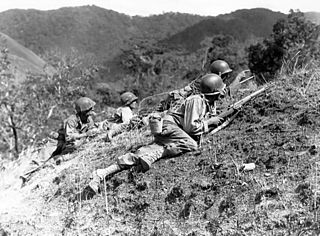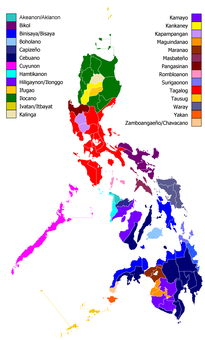
The history of the Philippines is believed to have begun with the arrival of the first humans using rafts or boats at least 67,000 years ago as the 2007 discovery of Callao Man suggested. Negrito groups first inhabited the isles. Groups of Austronesians later migrated to the islands.

Luzon is the largest and most populous island in the Philippines. It is ranked 15th largest in the world by land area. Located in the northern region of the archipelago, it is the economic and political center of the nation, being home to the country's capital city, Manila, as well as Quezon City, the country's most populous city. With a population of 53 million as of 2015, it is the fourth most populous island in the world, containing 52.5% of the country's total population.
The military history of the Philippines is characterized by wars between Philippine kingdoms and its neighbors in the precolonial era and then a period of struggle against colonial powers such as Spain and the United States, occupation by the Empire of Japan during World War II and participation in Asian conflicts post-World War II such as the Korean War and the Vietnam War. The Philippines has also battled a communist insurgency and a secessionist movement by Muslims in the southern portion of the country.

Rajah Sulayman, sometimes referred to as Sulayman III (1558–1575), was the Rajah or paramount ruler of the Rajahnate of Maynila, a fortified Tagalog Muslim polity which was a vassal to the Brunei Sultanate, on the southern half of the Pasig River delta, by the time Spanish colonizers arrived in the early 1570s.

Japanese settlement in the Philippines refers to the branch of the Japanese diaspora having historical contact with and having established themselves in what is now the Philippines. This also refers to Filipino citizens of either pure or mixed Japanese descent currently residing in the country, the latter a result of intermarriages between the Japanese and local populations.
Martín de Goiti was one of the soldiers who accompanied the Spanish colonization of the East Indies and the Pacific, in 1565. From his main base in Mexico City, he was the leader of the expedition to Manila, ordered by Miguel López de Legazpi in 1569. There, he fought a number of battles against the Muslim, Tariq Suleiman/Soliman, the Hindu Rajah Matanda, and the Taoist Lakandula of the kingdoms in Luzon; for control of the lands and its settlements. He is also known for his statesmanship by betrothing his sister to Batang Dula, the eldest son and successor apparent of Lakan Dula of Tondo, the paramount ruler of Manila. Eventually their descendants unified the 3 royal houses of Tariq Suleiman, Rajah Matanda and Lakan Dula with the Basque Goiti family. The Dula y Goiti family eventually married with the Mendoza family who came over from Latin-America, who were Sephardic Hebrews that were practicing Catholics. Afterwards, the Dula y Goiti surname was shortened to Dulay. However, during the Spanish era, some descendants changed their surnames even further in order to avoid persecution and among which; the Salonga and Macapagal families are known descendants of these royal houses albeit only through a different family name.
Battle of Manila may refer to:
Francis Fernándezde Capillas, O.P. was a Spanish Dominican friar who went as a missionary to Asia. He died in China as a martyr. He was canonized by Pope John Paul II on 1 October 2000, as one of the 120 Martyrs of China.

The Battle of Luzon, fought 9 January – 15 August 1945, was a land battle of the Pacific Theater of Operations of World War II by the Allied forces of the U.S., its colony the Philippines, and allies against forces of the Empire of Japan. The battle resulted in a U.S. and Filipino victory. The Allies had taken control of all strategically and economically important locations of Luzon by March 1945, although pockets of Japanese resistance held out in the mountains until the unconditional surrender of Japan. While not the highest in U.S. casualties, it is the highest net casualty battle U.S. forces fought in World War II, with 192,000 to 205,000 Japanese combatants dead, 10,000 American combatants killed, and between 120,000 and 140,000 Filipino civilians and combatants killed.

The Manila massacre involved atrocities committed against Filipino civilians in the City of Manila, the capital of the Philippines, by Japanese troops during World War II at the Battle of Manila. The combined death toll of civilians for the battle of Manila was about 100,000.

In early Philippine history, the Tagalog settlement at Tondo was a major trade hub located on the northern part of the Pasig River delta, on Luzon island.

News Patrol Kapampangan was a local news bulletin program broadcast of the ABS-CBN Regional Network Group in San Fernando, Pampanga. The program delivers the freshest news and current affairs issues in Pampanga.

In early Philippine history, the Tagalog Bayan of Maynila was a major trade hub located on the southern part of the Pasig River delta, where the modern day district of Intramuros currently stands.

The Rajahnate of Butuan was an Indic polity centered on present Mindanao island in the modern city of Butuan in what is now the southern Philippines. It was known for its mining of gold, its gold products and its extensive trade network across the Nusantara area. The kingdom had trading relationships with the ancient civilizations of Japan, China, India, Indonesia, Persia, Cambodia and areas now comprised in Thailand.

Manila's history begins around 65,000 BC the time the Callao Man first settled in the Philippines, predating the arrival of the Negritos and the Malayo-Polynesians. The nearby Angono Petroglyphs, are then dated to be around 3,000 BC and the earliest recorded history of Manila, the capital of the Philippines, dates back to the year 900 AD as recorded in the Laguna Copperplate Inscription. By the thirteenth century, the city consisted of a fortified settlement and trading quarter near the mouth of the Pasig River, the river that bisects the city into north and south.

Ethnic issues in the Philippines are multifarious and emerged in various portions of the history of people, institutions and territories coinciding to that of the present-day Philippines.
The Battle of Manila (1365) is an unspecified and disputed battle occurring somewhere in the vicinity of Manila between the forces of the kingdoms in Luzon and the Empire of Majapahit.
Sanfotsi, also written as Sanfoqi, was a wealthy trading polity in Southeast Asia mentioned in Chinese sources dated from the Song dynasty circa 12th century. In 1918, George Cœdès concluded that Chinese forms of San-fo-ts'i (Sanfoqi), Fo-ts'i (Foqi), Fo-che (Foshi), Che-li-fo-che (Shilifoshi), which correspond to Arabic Sribuza and can be reconstructed as Śribhoja, are names referring to the Srivijaya empire, located in Palembang, South Sumatra, in present-day Indonesia.

Caboloan, referred to Chinese records as Feng-chia-hsi-lan, was a sovereign pre-colonial Philippine polity located in the fertile Agno River basin and delta, with Binalatongan as the capital. It expanded its territory and influence from Pangasinan, to what are now the neighboring provinces of Tarlac, La Union, Benguet, Zambales, Nueva Ecija and Nueva Vizcaya, and had full independence until the Spanish conquest. It traded with the Kingdom of Ryukyu, Ashikaga shogunate and for trading with and sending gifts to Ming dynasty. The polity of Pangasinan sent emissaries to China in 1406–1411.

The following outline is provided as an overview of and topical guide to Metro Manila:












